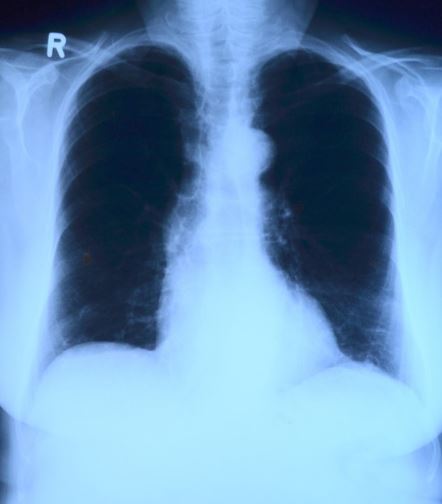
A recent study by the Swiss National Science Foundation has explicitly shown how asbestos fibers can cause cancer to develop in the body. The information is useful for clinicians who want more effective therapies to treat mesothelioma and also is of use in personal injury lawsuits so that plaintiffs’ attorneys have more ammunition in their effort to obtain compensation for mesothelioma victims. (Gilmorehealth.com)
Scientists have known for many years that asbestos is a dangerous carcinogen that can cause various types of cancer. Its long, pointed fibers can lodge in the lungs and other internal organs, cause long-term inflammation and make cancer develop.
Clinical researchers from the University Hospitals of Zurich, Geneva, and Toronto worked with scientists from the University of Fribourg and ETH Zurich to locate the mechanism by which the asbestos fibers damage body tissues and cause cancer.
According to lead study author Emanuela Felley-Bosco, long term exposure to asbestos fibers causes a form of tissue repair. The immune system tries to repair the damage but goes out of balance and cannot maintain the strength to fight the formation of tumors. The clinical research was published in Oncogene, a peer-reviewed magazine on cancer.
How Asbestos Cancer Forms in the Body
Interestingly, from a chemical perspective, asbestos is almost harmless to the human body. What makes it dangerous is its ability of the fibers to lodge in delicate tissue and cause micro-injuries over time. Asbestos works its way into the mesothelium, which is a layer of cells bordering organs in the human body. This occurs after it enters the lungs. The long, pointy fibers stay stuck in the area because the lymphatic system cannot get them removed from the lung tissue easily.
While the asbestos fibers are stuck in the mesothelium, the fibers can damage the tissue many times over years and this can cause cancer.
Researchers Studied Asbestos Damage In Mice
Clinical researchers studied mice in this particular clinical study. They injected asbestos fibers into the abdominal cavities of the mice, which also has mesothelium tissue as humans do.
Micro-injuries that were caused by the fibers triggered an immune reaction, and inflammatory signals were sent to alert white blood cells to take action. The inflamed mesothelium tissues indicated activation of tissue repair signaling activity. This encourages cells to proliferate, which can cause tumor growth.
A similar routine that was seen in the mice is seen in humans, researchers noted. This was observed by performing an analysis of data that was taken from a gene bank. Tumors of cancer patients with poor long-term outcomes produce higher amounts of enzymes that are related to RNA mutations.
Applications for the Clinical Study
Researchers in this clinical study noted their results could be useful to detect mesothelioma sooner, which could result in better patient outcomes. The research may be valuable to detect early signs of inflammation that could lead to mesothelioma.
SEE ALSO: Pleural Mesothelioma Cancer FAQ
One of the biggest problems with mesothelioma is cancer usually is not found until stage 3 or 4. At that point, cancer has spread to other parts of the body and treatment options are limited. Discovering cancerous inflammation sooner could lengthen lives.
The study results also could give physicians a better grasp of other medical conditions and cancers that are related to chronic inflammation. Some of these are Crohn’s disease and ulcerative colitis. Felley-Bosco noted that the research findings may help to develop more effective therapies for mesothelioma.
A cancer therapy that is used against immune system inhibitors is a very promising therapeutic approach, she said. These types of approaches are already being used to treat other forms of cancer today.
Clinical researchers in Spain, Switzerland and the UK are now wokring on ways that immunotherapy can help with advanced-stage mesothelial cancers.
A Related Study on Mesothelioma Identifies Three Sets of Tumors
There have been other progress made in mesothelioma research in recent months that could offer hope to victims of asbestos cancer. A new clinical study on malignant pleural mesothelioma was able to identify three different types of tumors with different molecular structures. (Gilmorehealth.com)
According to the WHO study, these different molecular profiles could offer more information on the clinical management and treatment methods for mesothelioma. This would potentially improve the understanding of the processes that lead to mesothelioma.
The lead author of the clinical study, Matthieu Foll, noted that innovative sequencing technologies that offer information on the molecular aspects of tumors can reveal subtle differences between tumors that initially looked similar in the microscope.
He noted that the expression of proteins related to the circulatory and immune systems of the tumors allowed the research team to pinpoint molecular profiles that may explain the differences in patient survival and treatment responses.
Most patients with malignant pleural mesothelioma usually die within two years of being diagnosed. It is a very rare and poorly understood cancer caused only by asbestos exposure. The problem with the disease is there is limited availability of effective treatments, and cancer usually is diagnosed at a late stage.
One reason for the limitations is there are so few molecular studies, as opposed to more robust research that has been done on other cancers.
While using asbestos has been banned in most countries, this type of mesothelioma still is a public health problem because it can take decades from exposure until the patient gets cancer. Also, the population that was exposed to the carcinogen are now reaching their 70s and 80s, which is the time when cancer often appears.



